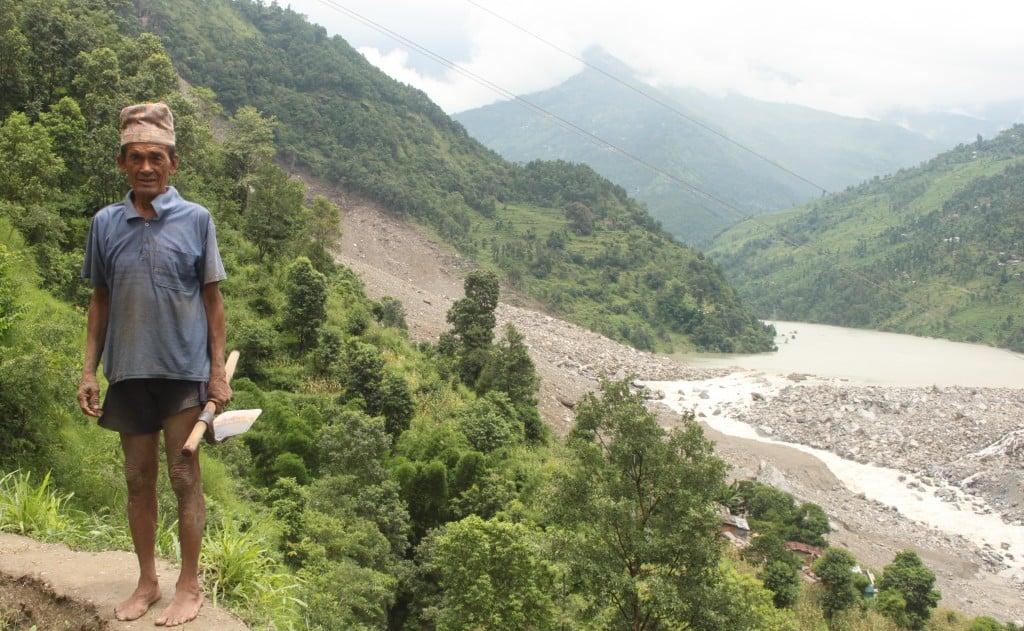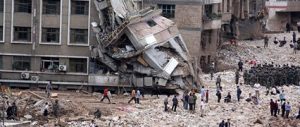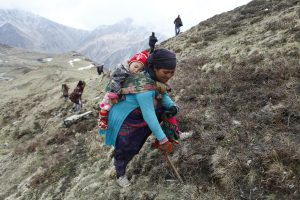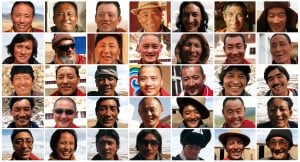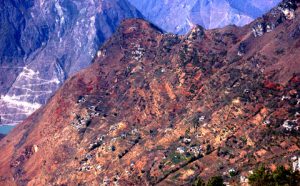Tara Adhikari and her two children live just a few metres away from the landslide that devastated the Sindhupalchowk district of Nepal two weeks ago.
Close by, the Nepal Army is setting off regular controlled explosions in an effort to drain water from the massive lake which formed when the landslide dammed the Sunkoshi River. With each explosion Adhikari recalls the faces of her neighbours who lost their lives.
Despite a government order for people to leave the area near the landslide, she is still living in the village. “They [the government] asked me to go to temporary camp – an hour’s walk from home – but who will look after my livestock? What will happen to this house built with a loan?” said Adhikari. “This is our lifetime investment and the result of our hard work, how can we leave this.” Three years ago her husband went to Qatar to earn money and he is still struggling to pay back the loan.
The massive landslide that hit the China-Nepal border on August 2 — washing away three villages and killing 156 people — has raised fears of flash floods downstream in Nepal and neighbouring India. The Indian government has evacuated 400,000 people from Bihar.
Helicopters pass frequently carrying people and goods between Kathmandu and Tatopani — a town bordering Tibet where over 1,000 pilgrims and tourists were stranded as they returned from trekking in Tibet.
The area is alive with activity and the sound of explosions, but the people who have stayed behind are trying to get on with their lives. Sixty-year-old Bishnu Parajuli lost his sister, two grandsons and nephew. “We were fortunate to get dead bodies and have already performed the last rites. We should move on with life despite of our troubles,” he said, as he busied himself in the field, preparing his rice for planting.
Only 33 bodies out of the 156 people declared dead have been recovered from the landslide that hit Sindhupalchowk. “We can smell dead bodies in the landslide, but it’s not possible to go there as boulders are still falling and the landmass is very unstable,” said a police officer on duty near the village.
More than 70 houses were swept away. One of the buildings destroyed by the landslide was the school where Ranjan Adhikari was studying in seventh grade. Six of his friends were killed in the landslide but he does not know how many others from his school died. The school building is now a pile of debris. “I hope my school will be reconstructed and I can attend school again,” he said as he carried maize from his field in a bamboo basket.
Most of the villagers living near the landslide stay at home during the day and go to temporary camps constructed by the government at night. But Sapana Karki is one of the few who are staying at home even at night. “We can’t leave this place as we don’t have options, we are ready to die if it is God’s will,” said Karki. She was also busy preparing her field for rice planting.
The families of victims blame the Nepal government for insufficient efforts to recover people trapped in the landslide and complain they have not been provided enough relief assistance. “We have received a packet of rice, pulses and some other food materials with mattress, that’s all what we have received,” said Bishnu Parajuli. Government officials said it is not possible to rehouse people immediately but refuted claims that they had provided insufficient relief materials. “We have enough food and other materials for victims. It has been distributed regularly so there shouldn’t be such an issue,” said Yubaraj Kattel, a local development officer and coordinator of the District Disaster Rescue and Relief Sub-Committee.
According to Kattel, about 500 people have been provided with relief packages but those who are living downstream are demanding support too, which the government is not able to provide. “There are thousands of people who live downstream of the landslide dam, although it is risky to stay in cities downstream. We cannot afford to provide relief for thousands up to the Nepal-India border,” added Kattel. Some parts of the Araniko highway — the major trade route linking Nepal and Tibet — have been completely destroyed in the landslide. “We have been trying to open up an alternative route and it should be in operation soon,” said Kattel.
Experts estimate the lake, which formed behind the landslide on the Sunkoshi River, contains more than eight million cubic metres of water. Efforts by the Nepal army to drain water have had limited success. “A regular flow of water has been maintained but it’s very challenging to drain out water stored in the dam putting thousands of lives downstream in danger,” said Subodh Dhakal, professor of geology at Tribhuvan University. “We have to do rigorous examinations but with general observations it doesn’t seem the dam will burst immediately as it’s a mixture of hard rock and mud,” added Dhakal. He was in the field to monitor the landslide.
According to Nepal’s Home Ministry, more than 4,000 people have been killed by landslides alone in Nepal in the last 40 years. Over 12,000 landslides occur each year in Nepal.
Although landslides are the second most hazardous disaster in the country after epidemics, very little has been done to prepare for these events or mitigate the destruction they wreak. Geologists have demanded the government prepare a detailed landslide map of the country and develop resettlement plans to reduce human casualties. “Given the magnitude of problem, there should be a separate agency to deal with landslides and conduct regular nationwide research”, said Subodh Dhakal. “Unfortunately less importance has been given [to landslides] despite of fragile geology of the country and no specific agency has been set up to deal with the issue.”
Experts say Nepal has very poor land use policies which allow people to settle wherever they own land. “With an increasing number of disasters and subsequent casualties, there is an urgent need for the government to implement a stricter land-use policy that allows human settlement only after rigorous geological studies,” said Kishore Thapa, recently retired as secretary in the Ministry of Urban Development and Planning. Nepal’s government has prepared a land use policy but there are still no laws to implement it.
